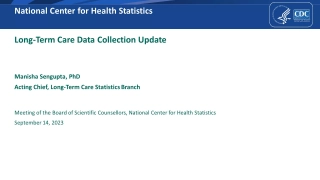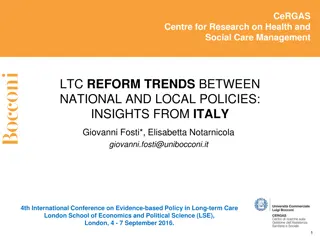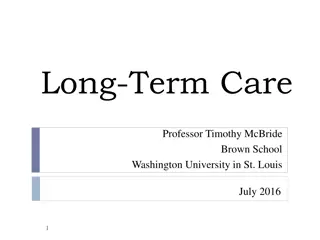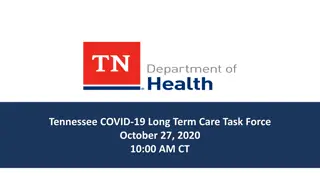Long-Term Care Framework Overview
This content discusses the Long-Term Care (LTC) Framework, including the incorporation of Uniform Standards tied to NAIC Model Law and Regulation, scope of reviewed products, coverage of LTC policies and rate schedules, and LTC Rate Review overview focusing on rate stability and actuarial requirements. It emphasizes consumer protections, product definitions, and standards for various LTC insurance vehicles.
Download Presentation

Please find below an Image/Link to download the presentation.
The content on the website is provided AS IS for your information and personal use only. It may not be sold, licensed, or shared on other websites without obtaining consent from the author.If you encounter any issues during the download, it is possible that the publisher has removed the file from their server.
You are allowed to download the files provided on this website for personal or commercial use, subject to the condition that they are used lawfully. All files are the property of their respective owners.
The content on the website is provided AS IS for your information and personal use only. It may not be sold, licensed, or shared on other websites without obtaining consent from the author.
E N D
Presentation Transcript
LONG-TERM CARE FRAMEWORK LONG-TERM CARE FRAMEWORK 1
Long-Term Care Framework Compact Statute ties LTC Uniform Standards to NAIC Model Law & Regulation: Standards shall provide same or greater protections for consumers as, but shall not provide less than the NAIC models, including subsequent amendments Uniform Standards amended in 2017 to incorporate 2016 amendments to NAIC Models #640 and #641. 2
Long-Term Care Framework Scope of products reviewed: products advertised, marketed or offered to provide benefits for one or more of the following: nursing home care, assisted living care or home health care and adult day care LTC insurance definition follows NAIC Model #640 definition LTC insurance definition excludes life policies that accelerate death benefits for chronic illness or annuities with guaranteed living benefits when the guaranteed withdrawal increases for certain events Standards for Accelerated Death Benefits do not apply to the products/riders within scope of LTC Policy Standards 3
Long-Term Care Framework Uniform Standards for LTC policies and rate schedules specifically cover all of these vehicles for providing LTC benefits: Stand-alone traditional LTC policy and rates Rider and rates to accelerate death benefit of life insurance policy or annuity contract Dollar for dollar LTC Insurance as defined Rider and rates to extend LTC benefits after exhaustion of policy death benefits/annuity account value Extension of Benefit rider 4
LTC Rate Review Overview Rate Filing Standards apply rate stability framework from NAIC Model #641 Actuarial memorandum required to contain A statement that the initial premium rate schedule is sufficient to cover anticipated costs under moderately adverse experience and that the premium rate schedule is reasonably expected to be sustainable over the life of the form with no future premium increases anticipated Detailed criteria for review requiring rates to be reasonable, non- discriminatory, based upon sound underwriting and sound actuarial principles reasonably related to actual or reasonably anticipated loss experience or expenses 5
Uniform Standards requirements Benefit trigger cannot be more than 2 activities of daily living (ADLs) Exclusion based on mental or nervous disorders are not permitted Exclusion due to a preexisting condition or disease limited to loss occurring within 6 months Coordination of benefit provision not permitted Must offer a product with inflation protection Must offer a product with issue age rates Must offer home health care benefits at 100% of nursing home benefits For home health care benefit options, coverage requirement of 50% of nursing home benefit minimum 7
Uniform Standards requirements Detailed information required for Initial Rate Filing Sample Rate Assumptions Spreadsheet provided Demonstration that margins do not deviate materially across issue ages Annual actuarial certification for rates Currently marketed rates Closed forms Triennial submission of supporting actuarial memorandum Rate increase filing may not introduce a rating characteristic that was not relied on in the initial rate filing 8
Serving as a Resource for the Committee The Compact Office takes no position on changes to the Model to accommodate designs that have been requested by the industry The Compact Office is happy to provide reviewer and actuarial resources for technical assistance SERFF Filing Access provides access to Compact-approved individual long- term care insurance products and riders The Compact Office publishes an annual report on Compact-approved iLTC Rate Schedule Certifications -- www.insurancecompact.org/documents/ic_ltc_rate_cert_report_201204.pdf The Compact Office provides a state-specific report to each Compacting State on iLTC products / riders and annual rate certifications 9
Examining Flexibility of the Model Guaranteed renewable limits products with fluctuating benefit designs Specification page requirements limit fluctuating premium rate schedule designs Benefit trigger is limited to inability to perform ADLs/cognitive impairment Limits designs which trigger on a time period such as 2 - 5 years before any benefit is payable even if policyholder becomes unable to perform ADLs Limits designs of converting life insurance to automatic LTC at certain point such a age 65 Rate stability limits ability to timely seek course corrections before MAE is gone Limits design allowing the premium rate schedule to fluctuate within a pre- approved range or band Limits periodic rate adjustments (smaller and more frequent) 10

 undefined
undefined

 undefined
undefined
























